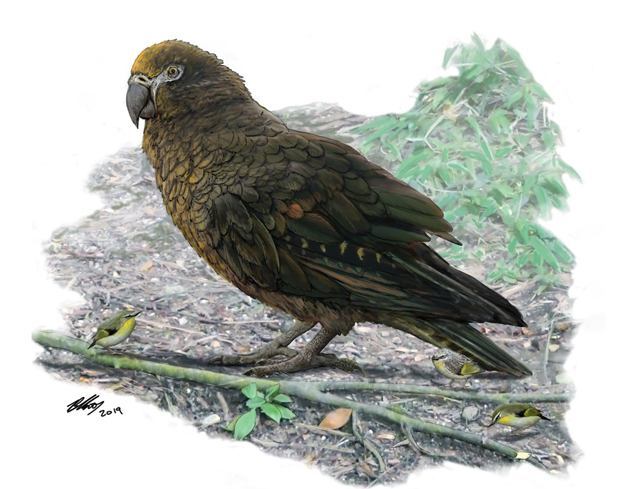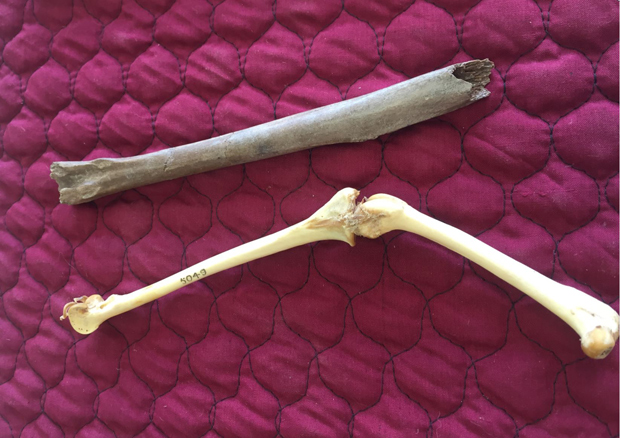The Very Peculiar Parrots of Ancient New Zealand
Heracles inexpectatus – A Prehistoric Parrot
We had known about this for a little while, but we wanted to keep our beaks firmly shut until the scientific paper had been published, the biggest parrot known to science has been announced. The metre tall, most probably flightless psittaciform roamed the South Island of New Zealand around 19 million years ago. Named Heracles inexpectatus it was part of a bizarre Miocene-aged biota that existed in New Zealand, the remains of which have been excavated from a riverbank on the Manuherikia River, Home Hills Station, Otago (Bannockburn Formation).
The fossil deposits are close to the small town of St Bathans, this area is renowned for its remarkable fossil deposits that record life in a sub-tropical forest environment which surrounded a huge, lake, which at its largest extent covered an area equivalent to nearly four times the size of the city of London.
A Life Reconstruction of Heracles inexpectatus

Picture credit: Dr Brian Choo (Flinders University)
Heracles inexpectatus – A Flightless Forager
Writing in “Biology Letters”, the researchers which include Associate Professor Trevor Worthy (Flinders University, Adelaide, South Australia), suggest that this parrot weighed around seven kilogrammes, and if it did, this makes it twice as heavy as the largest living parrot, the Kakapo (Strigops habroptilus), which also comes from New Zealand. H. inexpectatus has been described based on partial lower leg bones (the shafts of the left and right tibiotarsi), which were collected in January 2008. These two bones probably came from the same individual and since no other fossils related to a giant parrot have been found in the St Bathans area before, the discovery was quite unexpected, hence the trivial name of this new parrot species.
Comparing the Fossil Bone to the Leg Bones of an Extant Kakapo (Largest Living Parrot)
Picture credit: Flinders Palaeontology Laboratory
Commenting on this quite surprising discovery, Associate Professor Worthy stated:
“New Zealand is well known for its giant birds. Not only moa dominated avifaunas, but giant geese and adzebills shared the forest floor, while a giant eagle ruled the skies. But until now, no-one has ever found an extinct giant parrot – anywhere.”
Carnivore or Omnivore?
It is the leg bones that give an indication of the bird’s size. What it ate can be speculated upon, for example, in the absence of large mammalian predators Heracles could have been an apex predator, perhaps a hypercarnivore. The rarity of the fossils, could indicate it was relatively uncommon and therefore likely to be near the top of an ancient food chain.
Associate Professor Worthy added:
“We have been excavating these fossil deposits for 20 years, and each year reveals new birds and other animals. It [Heracles] was likely a flightless forager who ate abundantly on fruit and seeds but may have preyed on small animals that it could dig out of logs, or even snack on dead or dying moa.”
Co-author Professor Mike Archer (University of New South Wales), suggests that the feeding habits of such a large parrot could have been quite gruesome.
He explained:
“Heracles, as the largest parrot ever, no doubt with a massive parrot beak that could crack wide open anything it fancied, may well have dined on more than conventional parrot foods, perhaps even other parrots.”
More Amazing Fossil Finds from Otago Likely
Whilst the discovery of a giant prehistoric parrot is quite remarkable, the researchers are confident that the Miocene-aged sedimentary strata in this area (Manuherikia Group), will yield even more amazing fossils in the future. In these rocks, palaeontologists have discovered the fossilised remains of around forty different types of bird, as well as bats, frogs and a crocodilian.
These fossil deposits have provided palaeontologists with an insight into the rich avian fauna of prehistoric New Zealand. In 2018, Everything Dinosaur wrote about the discovery of fragmentary bones that suggested a type of prehistoric pigeon inhabited New Zealand during the Early Miocene: A New New Zealand Pigeon from the Early Miocene.
What’s in a Name?
A number of media outlets reporting this discovery have stated that the genus name Heracles honours the Greek hero (Hercules), renowned for his great strength. That is true, but the inspiration behind the genus name is a little more subtle than that. Some of the authors of this scientific paper about Heracles, were also involved in the discovery and naming of another much smaller parrot species from the Bannockburn Formation.
Nelepsittacus was named and described in 2011, its genus name was inspired by Neleus, who in Greek myth was the son of Poseidon and Tyro. Neleus refused to release Hercules from a debt and was murdered by Hercules, so it seemed logical to give the much larger psittaciform from the St Bathans Fauna a name honouring Hercules.
The scientific paper: “Evidence for a giant parrot from the early Miocene of New Zealand” (2019) by Trevor H Worthy, Suzanne J Hand, Michael Archer, R Paul Scofield and Vanesa L De Pietri published in Biology Letters.
Visit the Everything Dinosaur website: Everything Dinosaur.


